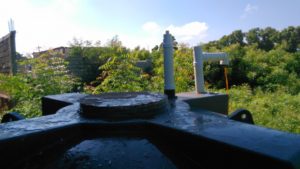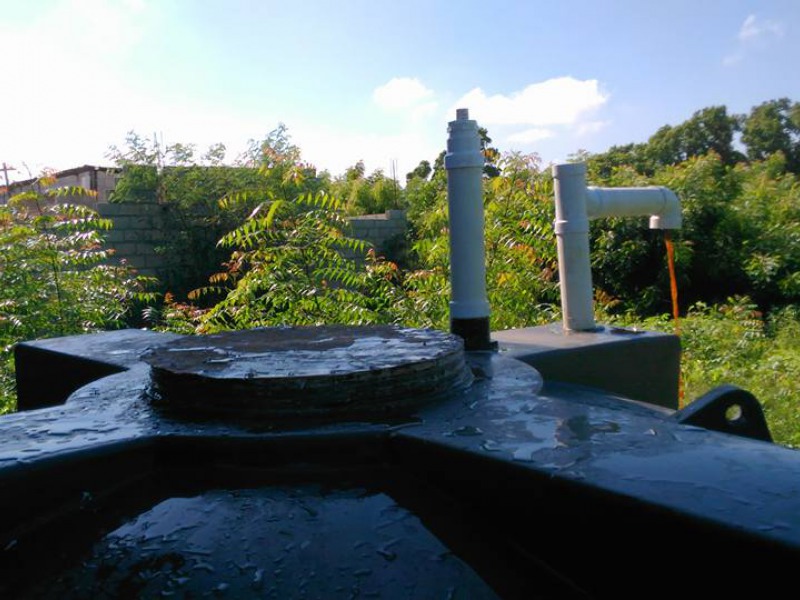
Using a metal plate, 40 one-inch screws, and RTV sealant we turned a 1000-gallon water tank into a digester. Everything else is the same as with our signature IBC digesters only bigger.
October 17, 2016
Immediately after Hurricane Matthew had passed, Solar CITIES co-founder and director Dr. T.H. Culhane, who teaches Environmental Sustainability and Justice and Sustainable Tourism at the Patel College of Global Solutions at USF Tampa, hopped over to Haiti to provide more “disaster resiliency training through local biodigester technology” at the Heart in Haiti school near Port Au Prince. Culhane was following up on work that Solar CITIES’ Communications Director Kathy Puffer had done earlier in the year.
The US Heart of Haiti team was led by Haitian-American Shad St. Louis and Maria Blon and included Tom Setchel and George Garland, who work with the Global Alliance for Clean Cookstoves and the UN. On a Doolittle Foundation Grant, Culhane and the US Heart of Haiti team spent three days sourcing parts and manure and building and commissioning a biogas digester large enough to meet the needs of the school. The team also met with teachers and activists from the school and from other parts of Haiti to discuss how to integrate biodigesters as a core technology in the curriculum to prevent more deforestation and air pollution caused by the use of firewood and charcoal.
The group was joined by Jean Rony Toussaintm, President/CEO at ASHOG Caring for People and Orphans: La Gonave Island HAITI. The part of Haiti that Jean comes from was particularly devastated by the Hurricane and saw many deaths. For Jean, the biodigester project was of particular interest because no effort to mitigate the affects of natural disasters can be effective if the tree cover that provides soil stabilization, flood control, natural sewage treatment, shading and nutritious food production is not protected from predation for cooking fuels.
Previously, Solar CITIES had introduced its IBC tank family size biodigester at the school. It has been used for the school gardener to cook every day for a couple of hours from a bucket of cafeteria waste. Because the school was already familiar with Solar CITIES digesters, the staff, teachers, and students were already enthusiastic about the prospect of using food-waste-to-fuel-and-fertilizer biogas for the new industrial oven in the school. This time the Solar CITIES team decided to repurpose a 1000-gallon water tank to be the prime digester. They also brought in Puxin solar powered biogas pumps and gas storage bags to increase pressure and capacity.
The team knew they could get the system started in just a few days, rather than the usual three to four weeks, because they used the bioactive slurry from the original IBC tank. What they were unsure of was whether they could successfully seal the tank, which cost $815. Culhane had tried using such tanks with poor results before in Egypt (2010), Botswana (2010), Kenya (2011), and Brazil (2013). The great challenge with these tanks is that the lids are not made to seal water tight and no amount of silicone, grease or rubber rings make an effective seal because there aren’t enough threads in the caps or neck to create the necessary screw down pressure. Culhane had success in Merida, Mexico at the Fundacion de las Haciendas Mundo Maya in 2014 when he used bolts and wing nuts. It was very cumbersome and difficult to get the bolts to stand upright in such a way as to get the lid on to place the wing nuts. Difficult as it was, we figured that we could try this as a last resort. We proceeded with the purchase of the tank on the first day. We had been delayed by the Hurricane for three days because Miami airport, in the path of the Hurricane, had been closed when we were originally supposed to leave, so we had to make quick decisions.
Gathering the manure (two full 200-liter barrels) was easy, if messy, because Haiti has many roadside cow stalls and we had the use of a pickup truck and lots of willing labor. Procuring the pipes was a bit more difficult because most Haitian plumbing shops only have really thin walled pipes which are flexible and prone to breaking. We eventually found what we needed after visiting several shops, which is not as easy as it sounds as the roads are dirt and rocks filled with potholes and mud so travel is very slow and messy). We had brought both schedule 35 and schedule 40 uniseals and the schedule 40 turned out to be the right ones.
Our Solar CITIES design, putting pipes in through the top of the tank, which we pioneered with IBC tanks in 2009, worked just as well, if not better, with the large water tank. We drilled the five-inch hole for the four-inch uniseal for the feed pipe and three-inch holes for two-inch uniseals for the slurry out pipes. We also drilled a two-inch hole for the two-inch bulkhead for the gas out through the hard plastic on the ridge supports of the tank, which kept them perfectly stable.
We filled the tank with the 400 kg of manure from the two barrels and then 3/4 of the way up with water pumped from the nearby stream. Then we poured enough water into the 1000-liter (275 gallon) IBC digester to displace 500 liters of active slurry which we then added to the 1000-gallon (4 cubic meter) new digester.
We were going to try and seal the original lid of the digester using RTV silicon sealant with grease around the few threads available and place weights on the lid until it dried, but toward the evening, as the sun was fading, we realized that the 3/4 inch hole at the top of the tank might give us problems because it wasn’t the right size for the bulkhead fitting we brought. Culhane drilled it out (losing his hole saw in the process into the tank!) and put in a half-inch uniseal instead with a piece of half-inch pipe and a valve. We decided to see if we could do a pressure test as we filled the digester with water over the level of the valve. This revealed that the lid was leaking like crazy, and when we removed it we learned that the lids on Haitian tanks are riddled with tiny holes and would never be able to seal no matter what.
In fact, the lids they have in Haiti would be impossible to seal even with bolts and wing nuts as Culhane had done in Mexico.
Tom Setchel came to the rescue with a better idea. He said, “Let’ make our own lid, out of a plate of steel, and bolt it into the plastic of the neck. I think it is thick enough.” So Shad St. Louis went racing off to find a metal smith who was still open, and returned with a rough-cut disk of metal and about 40 sheet metal screws. We spent the evening drilling holes with the battery powered drill I brought with me, praying the battery wouldn’t die and breaking several bits in the process. We put RTV sealant sandwiched between the flat plate and the neck and drilled and screwed and then left it until morning.
On our final day every body had to leave early for the airport except Tom and T.H., whose flights weren’t until noon. We got up at dawn, travelled over to the school and inspected the tank. All looked good, but we put in a few more screws to be sure, because part of the metal plate was warped and wouldn’t seal tightly. Then we did a pressure test by filling with water until the feed pipe was 20 cm full above the top of the tank (this is the normal operating pressure). What we saw was only a tiny micro leak where the plate was warped; it was slow enough that we figured it would eventually seal up with a micro biofilm as the bacteria did their job. And it appeared we were already making gas!
We hooked up the new gas bag and solar pump and connected the IBC system and the new tank system into one manifold of pipes so that they worked together. We also did tests of the industrial stove and educational workshopping with the local cooks and teachers.
A few days later we had our answer. Pictures and reports of successful gas bag filling and stove use began to appear in our Facebook group. Success!


